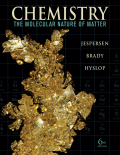
Chemistry: the study of matter and its changes
Jespersen, Neil D.
Brady, James E.
Hyslop, Alison
INDICE: Chapter 1 Chemistry and the Atomic/Molecular View of Matter. 1.1 Chemistry and Its Place Among the Sciences. 1.2 Laws and Theories: The Scientific Method. 1.3 Matter and Its Classifications. 1.4 Dalton and the Atomic Theory. 1.5 Atoms and Molecules and Chemical Formulas. 1.6 Chemical Reactions and Chemical Equations. Chapter 2 Scientific Measurements. 2.1 Physical and ChemicalProperties. 2.2 Measurement of Physical and Chemical Properties. 2.3 The Uncertainty of Measurements. 2.4 Dimensional Analysis. 2.5 Density and Specific Gravity. Chapter 3 Elements, Compounds, and the Periodic Table 3.1 Internal structure of the atom. 3.2 The Periodic Table. 3.3 Metals, Nonmetals, or Metalloids. 3.4 Ionic Compounds. 3.5 Nomenclature of Ionic Compounds. 3.6 Molecular Compounds. 3.7 Naming molecular compounds. Chapter 4 The Mole and Stoichiometry. 4.1 The molecular scale vs. the laboratory scale 4.2 Chemical formulas and stoichiometry. 4.3 Determining empirical and molecular formulas. 4.4 The Mole andChemical Reactions. 4.5 Limiting Reactants and Theoretical Yield. 4.6 Percentage Yield. Chapter 5 Molecular View of Reactions in Aqueous Solutions. 5.1 Describing Solutions. 5.2 Electrolytes, Weak electrolytes, and Non-electrolytes. 5.3 Acids and Bases. 5.4 Acid-Base Nomenclature. 5.5 Double-Replacement (Metathesis) Reactions. 5.6 Molarity. 5.7 Solution Stoichiometry. 5.8 Titrations andChemical Analysis. Chapter 6 Oxidation-Reduction (RedOx) Reactions. 6.1 Oxidation-Reduction Reactions. 6.2 Balancing Redox Reactions. 6.3 Acids as Oxidizing Agents. 6.4 Activity Series of Metals. 6.5 Molecular Oxygen as an Oxidizing Agent. 6.6 Stoichiometry of Redox reactions. Chapter 7 Energy and Chemical Change. 7.1 Energy: The Ability to do Work. 7.2 Internal Energy. 7.3 Measuring Heat. 7.4 Energy of chemical reactions. 7.5 Heat, Work and the First Law of Thermodynamics. 7.6 Heats of Reaction. 7.7 Thermochemical Equations. 7.8 Hess's Law. 7.9 Standard Heats of Reaction. Chapter 8 The Quantum Mechanical Atom. 8.1 Electromagnetic Radiation. 8.2 Line Spectra and the Rydberg Equation. 8.3 The Bohr Theory. 8.4 The Wave Mechanical Model. 8.5 Quantum Numbers of Electrons in atoms. 8.6 Electron spin. 8.7 Energy Levels and Ground State Electron Configurations. 8.8 Periodic Table and Ground State Electron Configurations. 8.9 Atomic Orbitals: Shapes and Orientations. 8.10 Periodic Table and Properties of the Elements. Chapter 9 The Basics of Chemical Bonding. 9.1 Energy Requirementsfor Bond Formation. 9.2 Ionic Bonding. 9.3 Electron Configurations of Ions. 9.4 Lewis Symbols: Keeping Track of Valence Electrons. 9.5 Covalent Bonds. 9.6 Covalent Compounds of Carbon. 9.7 Bond Polarity and Electronegativity. 9.8 Lewis Structures. 9.9 Resonance Structures. Chapter 10 Theories of Bonding and Structure. 10.1 Five Basic Molecular Geometries. 1
- ISBN: 978-0-470-57771-4
- Editorial: John Wiley & Sons
- Encuadernacion: Cartoné
- Páginas: 1224
- Fecha Publicación: 28/12/2010
- Nº Volúmenes: 1
- Idioma: Inglés
